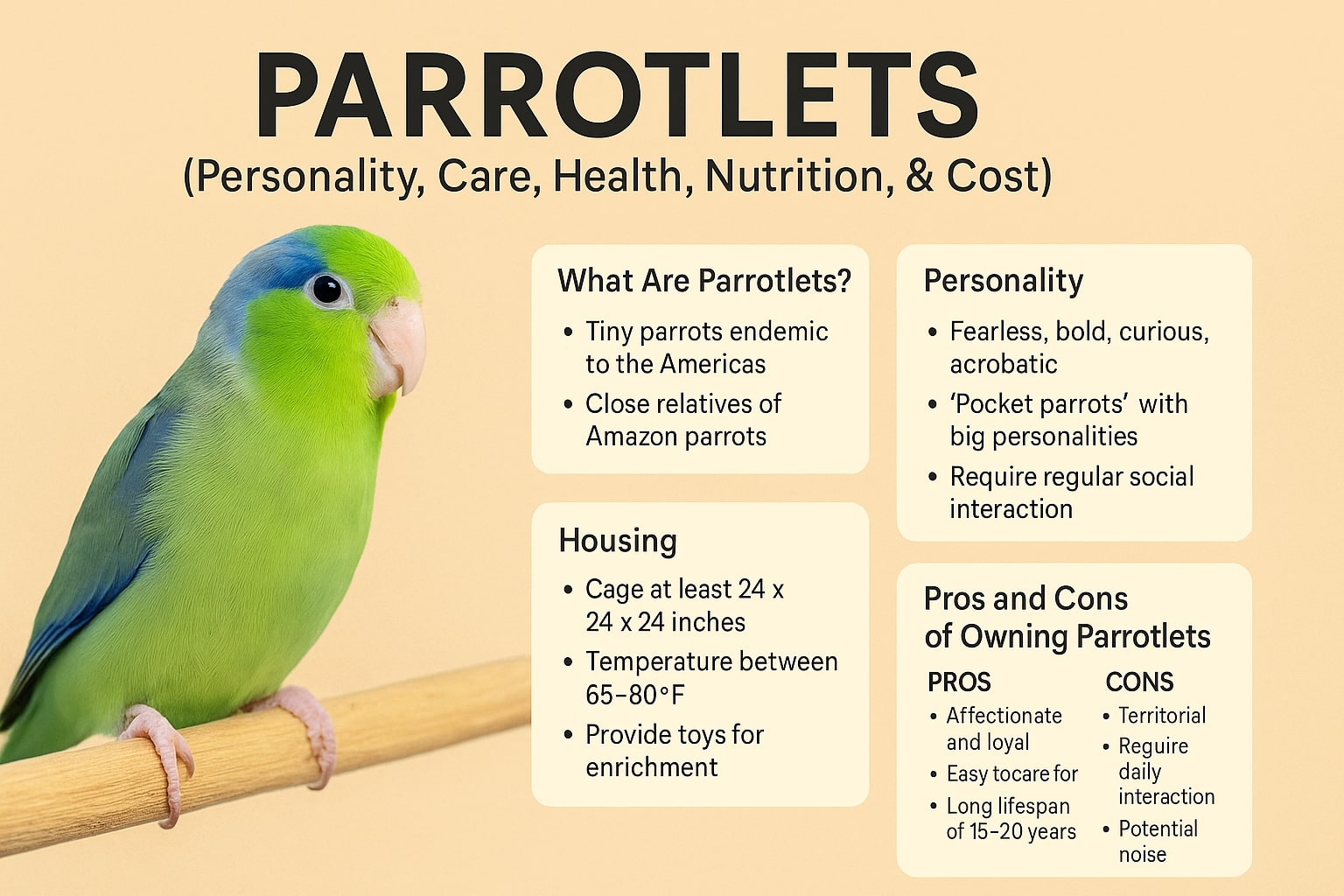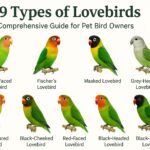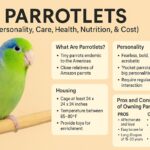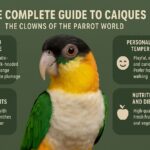Parrotlets have rapidly become one of the most sought-after companion birds in recent years, despite being virtually unknown just decades ago. These tiny feathered dynamos pack the personality of a large Amazon parrot into a compact body that measures less than six inches from head to tail2.
For pet bird enthusiasts seeking an intelligent, affectionate companion that doesn’t require massive amounts of space, parrotlets represent an ideal choice that combines big personality with small size requirements.
What Are Parrotlets?
Parrotlets are true parrots belonging to the family Psittacidae, making them genuine members of the parrot family despite their diminutive stature3. These remarkable birds are the smallest New World parrots, comprising several genera including Forpus, Nannopsittaca, and Touit.
Their stocky builds and short tails are endemic to Middle and South America, where they have earned the nickname “South American lovebirds” due to their size and behavior similarities to African lovebirds.
What makes parrotlets particularly fascinating is their close relationship to the much larger Amazon parrots. This connection explains why these tiny birds exhibit such bold, confident personalities that seem completely out of proportion to their size.
At less than six inches in length, parrotlets are actually smaller and more compact-looking than parakeets, though they possess much shorter tails than their budgerigar cousins.
Species and Varieties
There are seven recognized species of parrotlets, each with distinct characteristics and availability in the pet trade. The Pacific parrotlet (Forpus coelestis), also known as the Celestial parrotlet, stands as the most popular and commonly available species . These birds originate from western Ecuador and northwestern Peru, thriving in dry habitats such as desert and deciduous forests.
The Green-rumped parrotlet (Forpus passerinus) represents the second most common species in captivity. These birds are slightly smaller than Pacific parrotlets and tend to be somewhat shier and less active. They measure approximately 12 centimeters (4.7 inches) in length and weigh between 20-28 grams.
Other species include the Mexican parrotlet, Blue-winged parrotlet, Spectacled parrotlet, Sclater’s parrotlet, and Yellow-faced parrotlet. The Spectacled parrotlet has become increasingly available due to its ease of breeding, while species like the Yellow-faced parrotlet remain extremely rare, with only seven verified pairs existing in the United States.
Physical Characteristics and Sexual Dimorphism
Parrotlets are basically tiny green hookbills with striking sexual dimorphism that makes identifying males and females relatively straightforward. Males display beautiful blue coloration on their heads, wings, backs, and rumps, with the shade and placement varying by species. This blue can range from bright cobalt to pale lavender, particularly in American-bred birds.
Female parrotlets are predominantly green with yellow markings on their faces, undersides, and wings. The placement of these yellow markings helps identify different species, though this can be more challenging with females than males. Only in certain subspecies of Pacific parrotlets and Yellow-faced parrotlets do females display blue coloration on their rumps, heads, or wings.
Wild Pacific parrotlets exhibit green plumage with a dusty grey cast over the body, bright green masks, and pinkish beaks. Their legs and feet are pinkish-grey, while their eyes are dark brown. The birds undergo their first molt at approximately six months of age, after which their adult coloration remains relatively stable throughout their lives.
Color Mutations in Captivity
Selective breeding has produced an impressive array of color mutations in captive parrotlets, particularly in Pacific parrotlets. Almost all parrotlet color mutations are based on four primary colors: green (wild type), blue, gray, and turquoise. However, breeding programs have created numerous combinations and variations.
Popular mutations include albino parrotlets, which are among the rarest varieties and are characterized by a complete lack of color pigmentation and red eyes. American Turquoise parrotlets fall somewhere between green and blue variations, easily distinguished by their green masks compared to the blue masks of true blue mutations.
White mutations display obvious powdery blue coloring rather than pure white, while American Yellow varieties show lime green and yellow coloration.
Natural Habitat and Wild Behavior
In their natural environment, parrotlets inhabit diverse ecosystems ranging from deciduous forests to lowland woodlands and arid scrub environments. Wild parrotlets are found throughout South and Central America, with Pacific parrotlets specifically native to western Ecuador and northwestern Peru. They have adapted to both dry habitats like deserts and deciduous forests, and have even spread into humid areas following deforestation.
These social birds live and travel in flocks that can range from four birds to over one hundred, depending on the species and season. Most species typically travel in groups of five to forty individuals. Pacific parrotlets are commonly found in flocks of 40 to 50 birds along the borders of lowlands and foothills, in woodlands, shrubby clearings, gardens, parks, and agricultural areas.
Research has shown that parrotlets form lifelong, tight pair bonds with their chosen mates. Studies of Green-rumped parrotlets revealed that females occupy nest boxes for approximately 80% of daylight hours from shortly before egg laying through hatching, a period lasting 30-40 days. Males spend nearly 80% of their time away from the nest, presumably foraging for their mates and chicks.
Parrotlets as Companion Birds
Personality and Temperament
Parrotlets are often described as having the temperament of a large parrot trapped in a small bird’s body. Their personalities have earned them the nickname “pocket parrots” due to their fearless, mighty behavior. These birds are highly intelligent, bold, curious, and acrobatic, with the capacity to learn tricks and even mimic human speech.
The personality of parrotlets can be both charming and challenging. They are often referred to as the “terriers of the parrot world” due to their bold, feisty, and curious nature. Pacific parrotlets, in particular, seem unaware of their tiny size and show little hesitation in challenging other animals and humans. This confidence can be endearing but requires proper management to prevent behavioral issues.
Intelligence and Learning Ability
Parrotlets demonstrate remarkable intelligence for their size, with the ability to learn 5 to 10 words or phrases on average. Some exceptional individuals have been documented learning up to 200 words.
While their speech may not be as clear as larger parrots, parrotlets can effectively communicate with their human companions through vocalizations, body language, and learned behaviors.
Their intelligence extends beyond speech mimicry to include trick learning and problem-solving abilities. Parrotlets can learn complex behaviors such as putting coins into banks, performing multiple tricks in sequence, and responding to various training cues. This mental capacity requires consistent stimulation to prevent boredom and associated behavioral problems.
Social Needs and Bonding
Hand-fed parrotlets can develop profound bonds with their human caregivers, becoming devoted companions that seek attention and affection. However, their social needs must be carefully managed. If left alone for extended periods, a single parrotlet can lose some of its companionability. This makes regular interaction essential for maintaining a well-socialized bird.
The question of keeping single versus paired parrotlets is complex. While some experts recommend keeping two birds for companionship, this can result in the birds bonding primarily with each other rather than their human family.
Additionally, parrotlets can be quite aggressive toward other birds, even their own mates. Studies have shown aggression in 59% of parrotlet pair relationships, with one individual being significantly more aggressive in 35% of pairs.
Housing and Environmental Requirements
Cage Specifications
Proper housing is crucial for parrotlet health and happiness. The minimum cage size should be 24x24x24 inches with 1/2 inch bar spacing, though larger is always better. The cage should provide ample room for exercise and space for multiple toys to maintain mental and physical stimulation. Natural wooden perches of varying thicknesses are essential to promote proper foot health and prevent pressure sores.
The cage setup should follow the principle that “less is more” to ensure adequate flying space. Toys and perches should be positioned so that droppings cannot fall on other toys, perches, or food and water bowls. A sleeping area should be provided at the highest point in the cage, as parrotlets prefer elevated sleeping spots where they feel secure.
Temperature and Environmental Control
Parrotlets thrive in temperatures between 65 and 80 degrees Fahrenheit, though they can tolerate a wider range if necessary. The ideal temperature range for most birds falls between 18-26 degrees Celsius (65-80 degrees Fahrenheit). They can survive in temperatures ranging from 4-5 degrees Celsius to 32-33 degrees Celsius (40-90 degrees Fahrenheit), but comfort zones are much narrower.
Environmental factors such as humidity, ventilation, and lighting also play important roles in parrotlet health. The living area should be well-ventilated but draft-free to prevent respiratory infections. Steady temperatures are preferable to rapid fluctuations, which can stress the birds and compromise their immune systems.
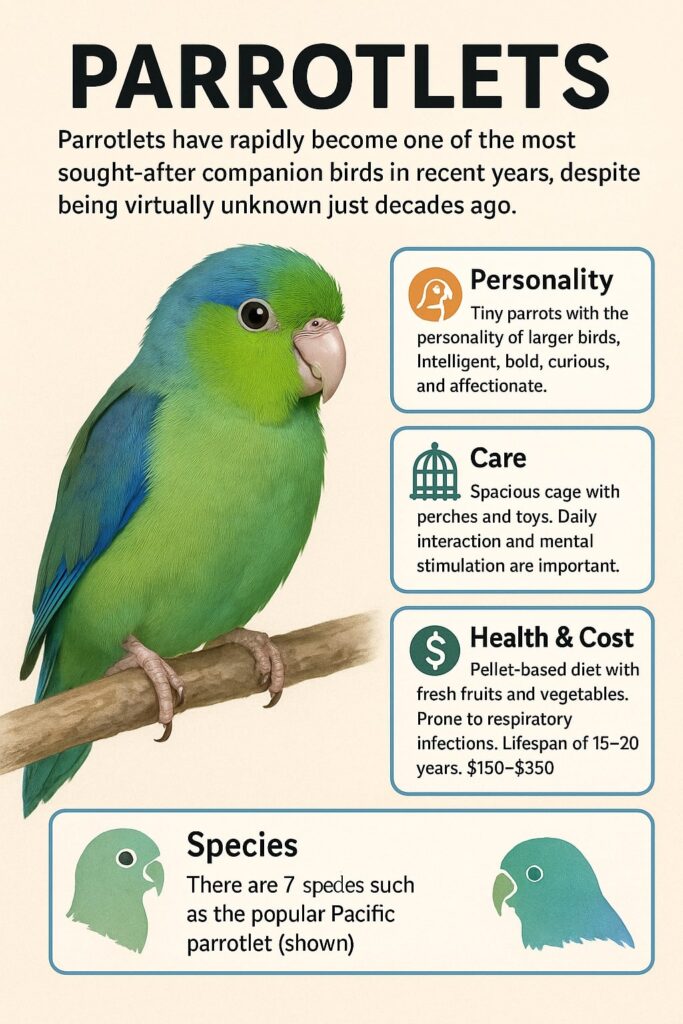
Nutrition and Feeding
Basic Diet Requirements
A proper parrotlet diet should consist primarily of high-quality pellets specifically formulated for small parrots. According to avian nutrition experts, approximately 70% of the diet should be nutritionally complete pellets, with the remaining 30% consisting of fresh fruits and vegetables. This ratio may vary depending on the bird’s lifestyle, life stage, species, and individual needs, but it provides a solid foundation for most parrotlets.
Many breeders feed parrotlets a combination of small parrotlet seed, egg food, and premium pellets from reputable manufacturers. While some sources suggest that parrotlets do best on seed-based diets, modern avian nutrition science indicates that pellets provide more complete nutrition. Small parrot species like parrotlets do need some seeds daily, but these should comprise no more than 10% of their total diet.
Fresh Foods and Supplements
Fresh fruits and vegetables should be offered daily to provide essential vitamins, minerals, and enrichment. Suitable options include carrots, broccoli, peas, de-seeded apples, grapes, pomegranates, blueberries, and various leafy greens. Fresh foods should be washed thoroughly and removed within a few hours to prevent spoilage.
Parrotlets require access to clean, fresh water at all times. Some birds may dirty their water quickly, necessitating multiple changes per day. Supplements such as cuttlebone and mineral blocks should be provided for calcium and mineral intake. Weekly weighing is recommended to monitor health and ensure proper nutrition.
Foods to Avoid
Several foods are toxic to parrotlets and must be strictly avoided. Avocado is highly poisonous to all parrots and can be fatal even in small amounts. Other dangerous foods include chocolate, caffeine, alcohol, apple seeds, fruit pits, onions, raw dairy products, and salty snacks. Foods high in salt, fat, and sugar should also be limited or eliminated from the diet.
Health and Veterinary Care
Common Health Issues
Parrotlets are generally robust birds, but they can be susceptible to several health conditions. Respiratory infections are among the most common ailments, often resulting from exposure to drafts, temperature changes, or contact with infected birds. Symptoms include sneezing, wheezing, nasal discharge, and labored breathing with tail bobbing.
Psittacosis, also known as parrot fever, is a zoonotic disease that can be transmitted from birds to humans. This bacterial infection caused by Chlamydia psittaci can be serious and requires immediate veterinary attention. Other potential health issues include fungal infections, digestive problems, and injuries from accidents due to their small size.
Preventive Care
Regular veterinary checkups with an avian veterinarian are essential for maintaining parrotlet health. Annual or twice-annual examinations can help detect problems early when they are most treatable. Maintaining proper cage hygiene, providing appropriate nutrition, and ensuring a stable environment all contribute to disease prevention.
Lifespan and Longevity
With proper care, parrotlets can live 15 to 20 years, with some individuals reaching 25 years in captivity. This longevity represents a significant commitment for potential owners and highlights the importance of consistent, quality care throughout their lives. As birds live longer due to improved nutrition and veterinary care, age-related conditions such as cataracts, arthritis, and cardiovascular disease may become more common.
Training and Behavior
Understanding Parrotlet Behavior
Parrotlets are known for their bold and sometimes feisty personalities. Despite their small size, they often behave like much larger parrots, displaying curiosity, territoriality, and a strong desire for social interaction. This means they can be both loving companions and challenging pets if not properly trained.
One common behavioral trait is their territorial nature. Parrotlets may become aggressive toward other birds or even humans if they feel their space is threatened. This behavior can manifest as biting, lunging, or loud vocalizations. Early socialization and consistent, gentle handling can help reduce territorial aggression.
Training Basics
Training a parrotlet requires patience, consistency, and positive reinforcement. These birds respond well to treats, praise, and gentle verbal encouragement. Start training sessions in a quiet, distraction-free environment and keep sessions short—about 5 to 10 minutes—to match their attention span.
Some basic commands and tricks to teach include:
- Step up/step down: Teaching your parrotlet to step onto your finger or a perch on command is fundamental for safe handling.
- Recall: Training your bird to come to you when called can be useful for bonding and safety.
- Simple tricks: Parrotlets can learn to wave, spin, or retrieve small objects, which provides mental stimulation.
Speech and Vocalization
While parrotlets are not the most talkative parrots, many can learn to mimic words and short phrases. Pacific parrotlets are generally the best talkers among the species. Consistent repetition, clear pronunciation, and rewarding attempts to speak encourage vocal learning.
It’s important to note that parrotlets also communicate through body language and sounds such as chirps, whistles, and squawks. Learning to interpret these signals helps owners understand their bird’s mood and needs.
Handling Biting and Aggression
Biting is a common issue with parrotlets, especially if they feel scared or threatened. To minimize biting:
- Avoid sudden movements or loud noises around your bird.
- Never punish your parrotlet physically; this can increase fear and aggression.
- Use positive reinforcement to reward calm behavior.
- Respect their boundaries; if the bird shows signs of stress, give it space.
If biting persists, consult an avian behaviorist or veterinarian for tailored advice.
Enrichment and Exercise
Importance of Mental and Physical Stimulation
Parrotlets are active and intelligent birds that require daily mental and physical stimulation to stay healthy and happy. Without sufficient enrichment, they can develop behavioral problems such as feather plucking, excessive screaming, or destructive chewing.
Toys and Foraging
Provide a variety of toys that encourage natural behaviors such as chewing, shredding, and problem-solving. Suitable toys include:
- Wooden blocks and chew toys
- Foraging toys that hide treats
- Bells and mirrors (used sparingly to avoid overstimulation)
- Puzzle feeders
Rotate toys regularly to maintain your bird’s interest.
Out-of-Cage Time and Flight
Parrotlets benefit greatly from supervised out-of-cage time. Allowing them to fly in a safe, enclosed space helps maintain muscle tone and mental health. If flight is not possible, encourage climbing and exercise with play gyms or ladders.
Social Interaction
Daily interaction with humans or other compatible birds is vital. Parrotlets thrive on attention and can become depressed or anxious if isolated.
Breeding Information
Is Breeding Right for You?
Breeding parrotlets requires considerable knowledge, time, and resources. It is recommended only for experienced bird owners or breeders. Before deciding to breed, ensure you understand the species-specific needs, genetics, and potential health risks.
Breeding Setup
A suitable breeding cage should be larger than a standard cage, with dimensions around 30x30x36 inches or more. Provide a nest box appropriate for parrotlets, typically a wooden box with an entrance hole about 2 inches in diameter.
Courtship and Mating
Parrotlets form strong pair bonds. Courtship involves mutual preening, feeding, and vocalizations. Pairs may become territorial and aggressive toward other birds during breeding season.
Egg Laying and Incubation
Females usually lay 4 to 6 eggs per clutch. Incubation lasts about 18 to 21 days, with the female primarily responsible for sitting on the eggs. The male provides food and protection.
Raising Chicks
Chicks hatch altricial (helpless) and require feeding every few hours. Hand-feeding chicks demands skill and commitment. Many breeders prefer to allow parents to raise their young unless hand-rearing is necessary.
Challenges and Considerations
Breeding parrotlets can be stressful for birds and owners. Potential issues include egg binding, nutritional deficiencies, and aggression. Veterinary support and proper husbandry are essential.
Choosing a Parrotlet
Selecting a Healthy Bird
When choosing a parrotlet, look for signs of good health:
- Bright, clear eyes
- Smooth, well-groomed feathers
- Active and alert behavior
- Clean nostrils and vent area
- Steady breathing without wheezing or clicking sounds
Avoid birds that appear lethargic, have fluffed-up feathers for extended periods, or show signs of discharge.
Age and Socialization
Hand-raised parrotlets tend to be more social and easier to tame than wild-caught or parent-raised birds. Young birds are generally more adaptable but require more training and socialization.
Finding a Reputable Breeder or Rescue
Purchase your parrotlet from a reputable breeder who prioritizes health and temperament. Alternatively, consider adopting from bird rescues or shelters to give a home to a bird in need.
Preparing Your Home
Before bringing a parrotlet home, prepare a safe, quiet space with a suitable cage, toys, and supplies. Research their care requirements thoroughly to ensure you can meet their needs.
Pros and Cons of Owning Parrotlets
Pros
- Small Size, Big Personality
Parrotlets are compact birds that fit well in smaller living spaces, such as apartments or homes without much room for large cages. Despite their size, they have bold, lively personalities that can rival much larger parrots. - Affectionate and Loyal
When hand-raised and socialized properly, parrotlets form strong bonds with their owners. They enjoy interaction and can be quite affectionate, often seeking attention and companionship. - Relatively Easy to Care For
Compared to larger parrots, parrotlets require less food and smaller cages, making them more affordable to maintain. Their diet is straightforward, and they adapt well to pellet-based nutrition supplemented with fresh foods. - Long Lifespan
With proper care, parrotlets can live 15 to 20 years, providing a long-term companion for dedicated owners. - Intelligent and Trainable
Parrotlets are smart birds capable of learning tricks, mimicking words, and engaging in interactive play. This intelligence makes them entertaining pets.
Cons
- Feisty and Territorial
Parrotlets can be aggressive, especially toward other birds or unfamiliar people. Their territorial nature means they require careful socialization and management to prevent biting and behavioral issues. - Require Daily Interaction
These birds need regular attention and mental stimulation. Without sufficient interaction, they can become bored, stressed, or develop destructive behaviors. - Not Ideal for Beginners
Due to their strong personalities and potential for aggression, parrotlets may not be the best choice for first-time bird owners. - Sensitive to Environmental Changes
Parrotlets can be sensitive to drafts, temperature fluctuations, and poor air quality, which can lead to respiratory problems. - Potential Noise
While not as loud as larger parrots, parrotlets can still be noisy, especially when seeking attention or feeling threatened.
Comparison with Other Small Parrots
Parrotlets vs. Budgerigars (Budgies)
- Size: Parrotlets are slightly larger and stockier than budgies.
- Personality: Parrotlets tend to be more assertive and confident, while budgies are generally more social and less aggressive.
- Talking Ability: Budgies are often better talkers and more vocal.
- Care Needs: Both species require similar diets and cage sizes, but parrotlets may need more social interaction to prevent aggression.
Parrotlets vs. Lovebirds
- Size: Both are small parrots, but lovebirds are usually a bit larger.
- Temperament: Lovebirds are social and often live in pairs, but can also be aggressive. Parrotlets are more territorial and may be aggressive toward other birds.
- Noise Level: Lovebirds tend to be noisier.
- Bonding: Lovebirds often bond strongly with their mates, while parrotlets may bond more with their human caregivers if kept singly.
Parrotlets vs. Cockatiels
- Size: Cockatiels are larger, with longer tails.
- Temperament: Cockatiels are generally more docile and easier to handle.
- Talking Ability: Cockatiels can whistle and mimic sounds but are less likely to speak words.
- Care: Cockatiels require larger cages and more space for flight.
Conclusion: Is a Parrotlet Right for You?
Parrotlets offer a unique combination of small size and big personality, making them a fascinating choice for bird lovers who want a lively, intelligent companion without the space and expense of larger parrots. Their boldness, curiosity, and affectionate nature can bring great joy to those willing to invest the time and effort needed to meet their social and environmental needs.
However, potential owners should be aware of their feisty temperament and territorial instincts. Parrotlets require consistent training, socialization, and mental stimulation to thrive. They are best suited for owners who have some experience with birds or are willing to learn about their specific behaviors and care requirements.
If you are prepared to provide a safe, engaging environment and commit to daily interaction, a parrotlet can become a delightful and entertaining member of your family for many years.
- Parrotlets (Personality, Care, Health, Nutrition, & Cost) - June 20, 2025
- Caique (Personality, Care, Health, & Nutrition) - June 20, 2025
- The Complete Guide to Golden Retrievers - June 9, 2025
